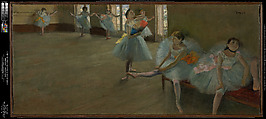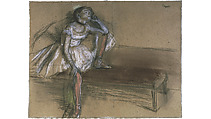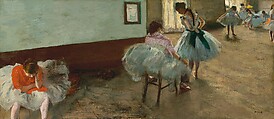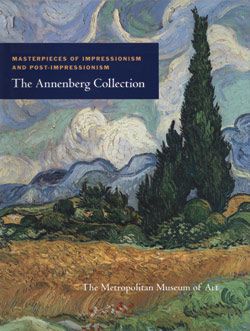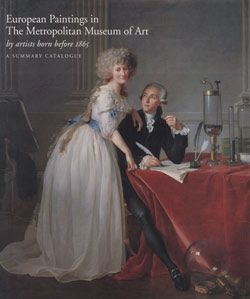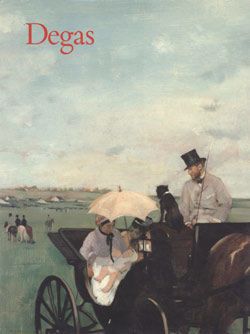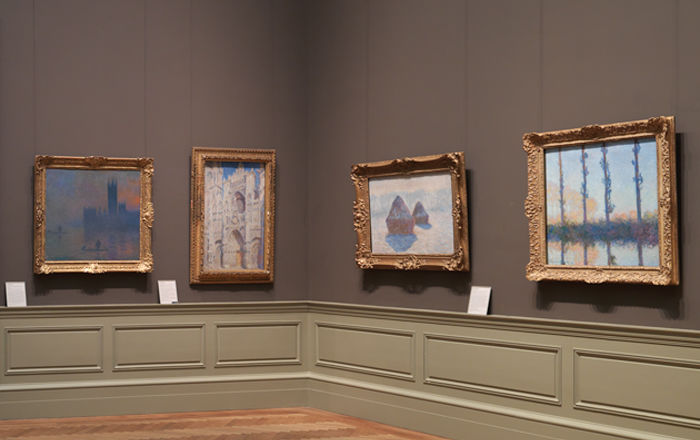The Pastel: A young ballet dancer stands in fourth position, with her feet turned out, as she holds a fan with her right hand and touches the nape of her neck with her left hand. She appears in a three-quarter view, and Degas has placed the figure, somewhat dramatically, on the diagonal that sweeps up from the left bottom of the paper to the top right, where his signature appears. Degas used little color in this pastel, focusing on the modeling and shading for the figure and the use of white for highlights on her tutu and bodice, particularly at the right collarbone, as well as at the top leftmost point of her hair. The only real addition of color is a small area of rust-colored pastel added atop black hatching just beyond the back of the dancer’s head, seemingly used to emphasize the outline of the back of her head (see below). The paper’s original gray-green color has faded a bit, appearing today as more of an ecru.
Dancer with a Fan as a Study: This pastel was used for the central figure in the painting
Dancers in the Classroom (see fig. 1 above; L820) (see Lemoisne 1946–49/1984). From the larger context of the Williamstown canvas, the viewer can see clearly that the dancers await the continuation of a lesson or rehearsal. There, what appears as a colorless fan in The Met’s pastel becomes a central focus for the painting with the bright addition of the red, white, and blue
tricolore colors of the French flag. There, too, the dancer’s tutu is longer, matching those of the other dancers in the classroom. The dancer’s dark hair contrasts with the bright daylight emanating from the French doors at the far end of the room beyond her. Perhaps it was with this pivotal focal point for the larger composition in mind that Degas employed the rust tone to set off the dancer’s head in The Met’s drawing. In contrast to the Clark’s final figure, The Met’s dancer appears twice as large. In fact, one writer referred to her as “almost monumentalised by her placing on the paper” (Meller 1990). Other changes to the figure in the final painting include the addition of a yellow sash around the figure’s waist that ties at the back and a red choker around her neck, matching that of the dancer at the left of her against the French doors. (Meller [1990] referred to this yellow sash as “perhaps the subtlest piece of haberdashery in the whole of nineteenth-century painting.” Kendall [2012] noted that Degas took liberties in introducing so many colored sashes onto the white practice tutus of the classroom.) Degas made several studies that relate to figures in the frieze-like canvas. One of these others, currently titled
A Coryphée Resting (fig. 2), has been identified by Meller as depicting the same model as The Met’s drawing, who was then, presumably, a coryphée (leading dancer in the corps de ballet). A strong use of white chalk for highlights populates this pastel, as in The Met’s pastel. That seated figure is a study for the dancer on the bench at far right in the Clark’s canvas. Meller suggests that both figures were altered slightly, both in the face and pose, for the final paintings. Kendall (2012) has noted that several of the studies for the Clark picture (for which he indicates a total of seventeen, mostly with larger-scale figures than in the painting) were signed and sold by Degas, thereby freeing them to an independent market status.
The dating of The Met’s pastel is based on that of the Williamstown painting, which, in turn, George Shackelford based on its stylistic similarity to
The Dance Lesson (fig. 3).[1] The Washington picture, formerly in the Mellon collection, was exhibited in the fifth Impressionist exhibition in 1880 and was based on a drawing in a notebook that was completed by about 1878. Shackelford dated the Williamstown composition to about 1880.
Little Dancer and Marie van Goethem(?): Meller (1990) called Marie van Goethem, the model for Degas’s sculpture
The Little Fourteen-Year-Old Dancer (see, for example, The Met
29.100.370), “a relative” of the central dancer in the Clark painting. Richard Kendall (1998) remarked upon the dancer in The Met ‘s drawing’s “slender physique and taut features” that “have much in common” with the model for the sculpture. Not only was the original wax sculpture version of
The Little Fourteen-Year-Old Dancer nearly contemporaneous with
Dancer with a Fan, Degas worked on images of the model Marie van Goethem before completing his
Little Dancer. It is possible (though uncertain) that The Met’s pastel is one of them.
A Note on the Dancer’s Gestures: Contrary to Pantazzi (1988), this author does not feel that “with the fan unfolded before her she has the manner of an adult perfectly aware of the arsenal of meanings she could convey with a movement of her wrist” or that “there is more than a hint that she is striking an attitude—indeed, that with a toss of her head she almost defies the viewer.” While there is a long history in both the Western and Eastern traditions of the fan used for flirtation, Pantazzi’s reading here presupposes a degree of conscious planning on the part of the dancer that seems overdetermined. With arm raised most likely to massage her tired muscles, the dancer is more likely to have been unaware of her viewer and caught off-guard by Degas, as in so many of his other presentations of them. Whether simply exhausted or in a moment of “self-contained reflection” (Meller 1990), the dancer’s gestures, rather than invoking the viewer, seem to carry on despite the artist/viewer’s presence.
Jane R. Becker 2023
[1] George Shackelford,
Degas: The Dancers, exh. cat., National Gallery of Art, Washington, 1984, pp. 86–87.


